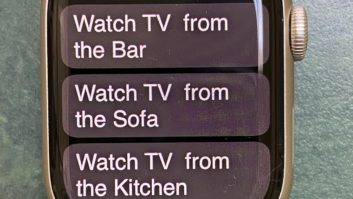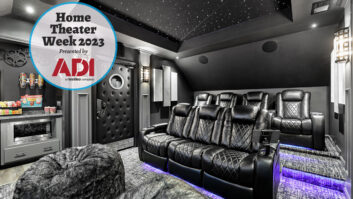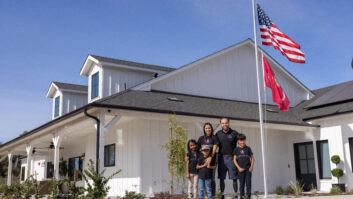I’ve had my new black sports band Apple Watch for about three weeks and have now developed some first impressions on what I think its impact could be on the custom electronics industry. Unlike the Apple touchscreen products (the iPhone and iPad) that came before, the Watch’s immediate role in home control and automation is not nearly as clear. It is most likely the reason that some large players in our industry are still on the sidelines.
Crestron and Savant are committed to the new platform, yet we have not seen anything from Control4. Sonos and NEST are also conspicuously absent, but Lutron does have Apple Watch control. Interestingly enough, when leading companies such as Sonos and Nest don’t provide smart watch control of their products, enterprising third-party companies are there to sell their Apple Watch control software to fill this void, even if it is a temporary one. ZonePlay and Kronos make a pretty good Apple Watch Sonos controller, Nest App and NestControl make an Apple Watch Nest controller, and the Drip app allows you to view your Dropcams on the watch.
One of the key considerations for using the Apple Watch for home and remote control is its usability compared with the smartphone interface. In the smartphone world we can get immediate access to our home control apps by launching one unified home controller app (like Savant, Crestron, or Control4) or by opening a home control folder that contains all the individual home control apps (like Sonos, Lutron, and Nest). We can access these apps quickly and interface with them intuitively. The watch interface needs to have this same (or better) level of interaction with our home systems to be useful over the long term.
There is, however, one Apple Watch OS software feature that could provide a level of seamless interaction for the control of home systems. With “Glances,” you can easily sweep away the clock interface of the watch to view your front door camera. One more swipe and you can arm or disarm the home. Another swipe and you can control the Sonos whole-house music system. One more swipe lets you control your Apple TV. These swipe actions are very easy and intuitive to learn and invoke.
The problem is that opening an app on an Apple Watch requires a level of precision finger pointing to launch a very small app icon. If you miss the app, then you launch the wrong one. In addition the watch screen can become quickly crowded with app icons, making them difficult to find. You can’t create folders for home control apps on the watch screen interface, but you can move them together to find them a little more easily.
My suggestion to custom integrators that are beginning to deploy Apple Watch home control for their clients is to select the top four or five control features that their client wants to deploy and include them in the Glanceable screens of the watch. All other secondary control features are best left as watch applications.



From left, DropCam, Lutron, and ZonePlay apps for the Apple Watch
There is another factor that has inhibited our industry’s rapid embrace of the Apple Watch for control. Specifically, most apps on the watch need to be wirelessly tethered to a nearby iPhone, and the apps generally do not run that fast on the Watch. Fortunately that promises to change this fall with a new Watch OS2 operating system that will allow developers to write apps that can run native on the watch without the use of the phone, and run much more quickly.
I predict that many hardware manufacturers that have not yet released a Watch app will do so for OS2. And just as each iOS release gave clients a richer smartphone experience, expect the same in the smart watch space. The Watch app wave will also continue to build momentum. When Apple first introduced the Watch it announced that there were more than 3,000 apps already written for the watch. A few months later that number has eclipsed 5,000. Expect that by the end of the year this number will be more than 10,000. Of those apps many will be in the home control space.
It’s also important to keep note that the Watch has some very unique experiences that will find their way into the home control experience. With haptic response, for example, if you forget to arm your home when you leave or close the garage door, your Watch will vibrate on your wrist with a reminder. As products begin to roll out under the Apple HomeKit umbrella, we also can expect to see the Siri voice functionality of the Watch enable commands such as turning on and off lights or opening and closing door locks. As Watch apps embrace location awareness, expect their usefulness to increase as well. Imagine walking into a Sonos audio zone where the Watch knows that you are in the kitchen zone, and you can immediately bring up the kitchen Sonos audio interface on your watch to adjust the volume and music content in this room–no more fumbling through rooms to figure out which one you are in.
The Apple Watch will clearly have an impact on our custom electronics industry, but it will take some time before it becomes as ubiquitous as these smartphone and tablets for home control. We sell custom integrated and control solutions to our clients, and the Apple Watch inevitably will become part of those solutions.







